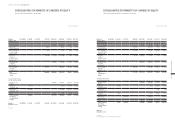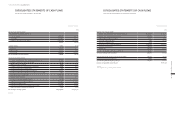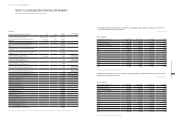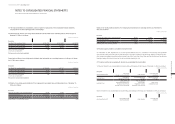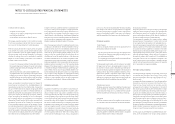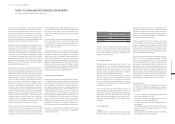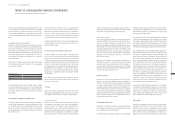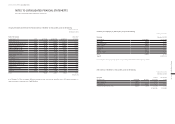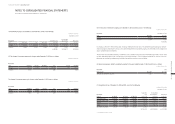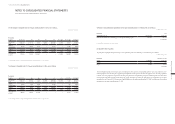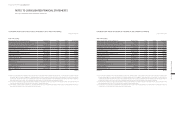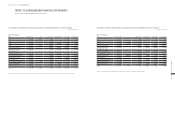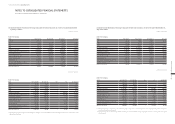Hyundai 2014 Annual Report Download - page 52
Download and view the complete annual report
Please find page 52 of the 2014 Hyundai annual report below. You can navigate through the pages in the report by either clicking on the pages listed below, or by using the keyword search tool below to find specific information within the annual report.
HYUNDAI MOTOR COMPANY Annual Report 2014
FINANCIAL STATEMENTS / 103102
The cost of an internally generated intangible asset is the sum
of the expenditure incurred from the date when the intangible
asset first meets the recognition criteria above and the carry-
ing amount of intangible assets is presented as the acquisition
cost less accumulated amortization and accumulated impairment
losses.
3) Intangible assets acquired separately
Intangible assets that are acquired separately are carried at
cost less accumulated amortization and accumulated impair-
ment losses. Amortization is recognized using the straight-line
method based on the estimated useful lives. The Group reviews
the estimated useful life and amortization method at the end of
each annual reporting period. If expectations differ from pre-
vious estimates, the changes are accounted for as a change in
accounting estimate.
Amortization is computed using the straight line method based
on the estimated useful lives of the assets. The representative
useful lives are as follows:
Representative useful lives (years)
Development costs 3 - 6
Industrial property rights 4 - 13
Software 2 - 10
Other 2 - 40
Club membership included in other intangible assets is deemed
to have an indefinite useful life as there is no foreseeable limit
on the period over which the membership is expected to gener-
ate economic benefit for the Group, therefore the Group does
not amortize it.
(15) Impairment of tangible and intangible assets
The Group assesses at the end of each reporting period wheth-
er there is any indication that an asset may be impaired. If any
such indication exists, the Group estimates the recoverable
amount of the asset to determine the extent of the impairment
loss. Recoverable amount is the higher of fair value less costs to
sell and value in use.
incurred in negotiating and arranging an operating lease are
added to the carrying amount of the leased asset and recognized
as expense on a straight-line basis over the lease term.
2) The Group as lessee
Assets held under finance leases are initially recognized as
assets and liabilities of the Group at their fair value at the in-
ception of the lease or, if lower, at the present value of the
minimum lease payments. Minimum lease payments are appor-
tioned between the finance expenses and the reduction of the
outstanding liability. The finance expenses are allocated to each
period during the lease term so as to produce a constant pe-
riodic rate of interest on the remaining balance of the liability.
Contingent rents are recognized as expenses in the periods in
which they are incurred.
Operating lease payments are recognized as expense on a
straight-line basis over the lease term, except where another
systematic basis is more representative of the time pattern in
which economic benefits from the leased asset are consumed.
Contingent rents for operating lease are recognized as expenses
in the periods in which they are incurred.
(18) Borrowing costs
Borrowing costs directly attributable to the acquisition, con-
struction or production of qualifying assets are capitalized to
the cost of those assets, until they are ready for their intended
use or sale. A qualifying asset is an asset that necessarily takes
a substantial period of time to get ready for its intended use or
sale. Investment income earned on the temporary investment
of specific borrowings pending their expenditure on qualifying
assets is deducted from the borrowing costs eligible for capital-
ization. All other borrowing costs are recognized in profit or loss
in the period in which they are incurred.
(19) Retirement benefit plans
Contributions to defined contribution retirement benefit plans
are recognized as an expense when employees have rendered
service entitling them to the contributions.
The retirement benefit obligation recognized in the consolidated
If the cash inflow of individual asset occurs separately from
other assets or group of assets, the recoverable amount is
measured for that individual asset; otherwise, it is measured for
each CGU to which the asset belongs. Except for goodwill, all
non-financial assets that have incurred impairment are tested
for reversal of impairment at the end of each reporting period.
Intangible assets with indefinite useful lives or intangible assets
not yet available for use are not amortized but tested for im-
pairment at least annually.
(16) Non-current assets classified as held for sale
The Group classifies a non-current asset (or disposal group) as
held for sale if its carrying amount will be recovered principally
through a sale transaction rather than through continuing use.
For this to be the case, the asset (or disposal group) must be
available for immediate sale in its present condition subject only
to terms that are usual and customary for sales of such assets
(or disposal groups) and its sale must be highly probable. The
management must be committed to a plan to sell the asset (or
disposal group), and the sale should be expected to qualify for
recognition as a completed sale within one year from the date
of classification.
Non-current assets (or disposal group) classified as held for
sale are measured at the lower of their carrying amount and
fair value less costs to sell.
(17) Lease
Leases are classified as finance leases when the terms of the
lease transfer substantially all the risks and rewards of ownership
to the lessee. All other leases are classified as operating leases.
1) The Group as lessor
Amounts due from lessees under finance leases are recognized
as receivables at the amount of the Group’s net investment in
the leases. Finance lease interest income is allocated to ac-
counting periods so as to reflect an effective interest rate on
the Group’s net investment outstanding in respect of the leases.
Rental income from operating leases is recognized on a straight-
line basis over the term of the relevant lease. Initial direct costs
statements of financial position represents the present value of
the defined benefit obligation, less the fair value of plan assets.
Defined benefit obligations are calculated by an actuary using
the Projected Unit Credit Method.
The present value of the defined benefit obligations is measured
by discounting estimated future cash outflows by the interest
rate of high-quality corporate bonds with similar maturity as the
expected post-employment benefit payment date. In countries
where there is no deep market in such bonds, the market yields at
the end of the reporting period on government bonds are used.
The remeasurements of the net defined benefit liabilities (as-
sets) comprising actuarial gain or loss from changes in actuarial
assumptions or differences between actuarial assumptions and
actual results, the effect of the changes to the asset ceiling and
return on plan assets, excluding amounts included in net interest
on the net defined benefit liabilities (assets) are recognized in
other comprehensive income of the consolidated statements
of comprehensive income, which is immediately recognized as
retained earnings. Those recognized in retained earnings will
not be reclassified in profit or loss. Past service costs are rec-
ognized in profit and loss when the plan amendment occurs and
net interest is calculated by applying the discount rate deter-
mined at the beginning of the annual reporting period to the
net defined benefit liabilities (assets). Defined benefit costs are
composed of service cost (including current service cost, past
service cost, as well as gains and losses on settlements), net in-
terest expense (income), and remeasurements.
The retirement benefit obligation recognized in the consolidat-
ed statement of financial position represents the actual deficit
or surplus in the Group’s defined benefit plans. Any surplus
resulting from this calculation is limited to the present value of
any economic benefits available in the form of refunds from the
plans or reductions in future contributions to the plans.
(20) Provisions
A provision is recognized when the Group has a present obliga-
tion (legal or constructive) as a result of a past event, it is prob-
able that an outflow of resources embodying economic benefits
will be required to settle the obligation, and a reliable estimate
can be made of the amount of the obligation. The amount rec-
ognized as a provision is the best estimate of the consideration
NOTES TO CONSOLIDATED FINANCIAL STATEMENTS
AS OF AND FOR THE YEARS ENDED DECEMBER 31, 2014 AND 2013


